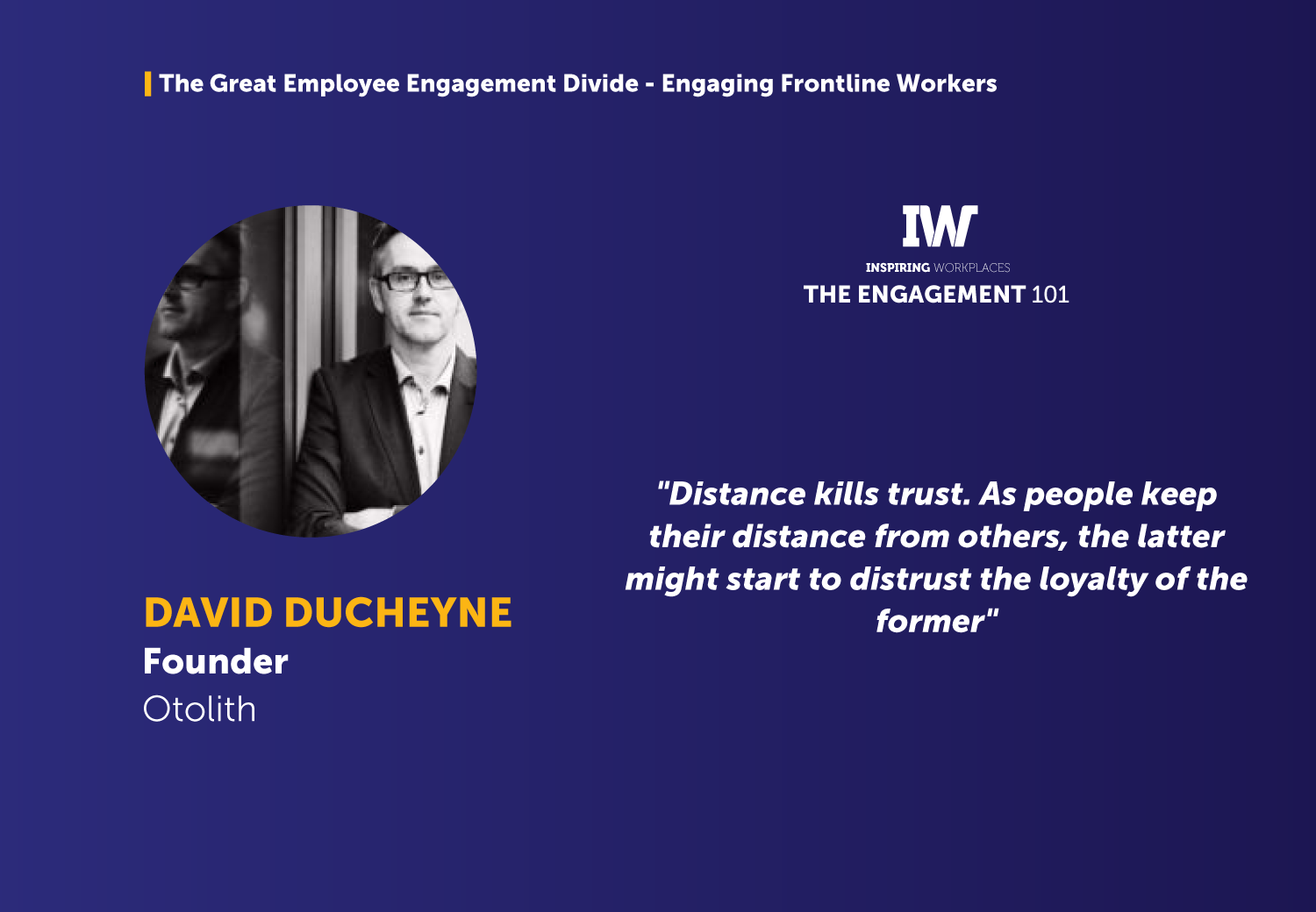
04th November 2021
The Great Employee Engagement Divide – Engaging Frontline Workers – David Ducheyne

This snippet is part of our Ebook The great Employee Engagement Divide – Engaging Frontline Workers. Advice and suggestions from our Top 101 influencers. You can download the full eBook with all the advice here.
David Ducheyne, Founder, Otolith Consulting
The Big Divide?
Focusing on frontline workers is good for business.
Any organization benefits from the fact that people are willing and able to work together to accomplish tasks. The bigger an organization gets, the more challenging this becomes. The enemy here is the distance people experience between them. This distance is not only about physical space. The distance can be cultural, hierarchical, and emotional too.
The moment the distance becomes too great, unrest starts. In his book on Justice, John Rawls wrote that people could endure inequality as long as there is a benefit for everybody. People understand that not everybody is the same and has the same job with the same responsibilities, rights, and duties. But the moment they see that there is no benefit in the unequal treatment, they will resent it.
Covid has taught us this lesson. To say that Covid has hit everybody as hard is not valid. It has hit the poor, the ill harder than the rich and the healthy people. And in terms of coping with the pandemic, there were many differences. People working as cashiers, garbage collectors, medical staff had to continue working in often dire circumstances, while the office workers, the knowledge brokers, the social media artists, the abstract thinkers could retreat in their home fortress to protect themselves against the pandemic. It’s like the Decameron all over again, the book by Giovanni Boccacio that describes a group of wealthy people who retreated in their summer house to protect themselves against the plague 500 years ago. They killed time by telling each other stories as people were dying outside.
Distance kills trust. As people keep their distance from others, the latter might start to distrust the loyalty of the former. And this has happened. I have witnessed regional managers in retail who struggled to visit the stores against the advice of their hierarchy because they did not think it was correct to leave the people alone under challenging circumstances. I saw unions demanding compensations for the people who had to work while others could benefit from telework. Some people did not show up, saying they were sick when they were not.
And with the so-called hybrid work arrangements coming up, those who cannot go into hybrid mode might feel left out. Just think of this example. A planner works from home that day that a shipment goes awry. The warehouse worker does not know what to do as the dispute escalates between him and the lorry driver. In those cases, it’s the planner that will deliberate. But the planner is at home. So the warehouse worker calls the planner on his mobile device and finds the planner sitting in the garden, drinking his green tea. The conflict with the lorry driver did not get resolved as the discussion did not go well. In the past, the planner came to the warehouse to discuss and resolve the issue.
I know it’s not a fair example, and anecdotes should not lead us. But having people at home while others have to come does not help the collaboration. It creates distance, and people might resent it. So here’s the question: how can we people who are working in the frontline?
1. Make sure people in the front feel that they are respected. Avoid hollow phrases and short-term incentives. Instead, leaders should join frontline workers to know their issues and acknowledge the challenges these people face when dealing with customers or suppliers. In lean management, this is called “go to Gemba.” By doing so, leaders reduce the distance.
2. Define a working model that does not create a hassle for anybody. If people are working from home, those working in the front must be able to work smoothly. Nobody can experience a disadvantage because of the flexible arrangements of others. So, even though some people could work more flexibly, they should adapt to the organization’s needs.
3. Make sure nothing is permanent and review the situation regularly. If a particular work arrangement does not work out, change it.
4. Discuss issues on the team level. A team is not a structural group of people; it’s a group of people who work with one another and depend on each other, even when they work in different departments. So, give voice to those who might not have one and listen deeply to what is going on.
5. Reduce the effort where possible. The moment people have a sense of abandonment, something is going on. The magic word is consistency here. So, if your frontline workers need to be customer-centric, make sure that everybody helps them. And make sure that all the procedures, technologies, and work arrangements support them. There is nothing worse for a frontline worker not to have the tools and support they need to serve their customer well. And if the frontline worker has to put in a lot of effort, the chances are that the customer will have to do so too. And that hurts the business
Never forget that a business thrives thanks to the frontline workers. And even when organizations are digitalizing the contact with their customers, don’t forget that the day a customer will need direct contact, the frontline worker will need to step up. And as many jobs are not teleworkable or not digitizable, it’s better to take care of the frontline workers as they make or break an organization’s reputation.

